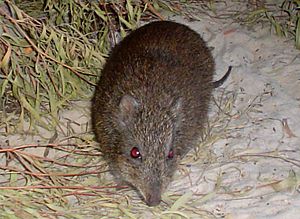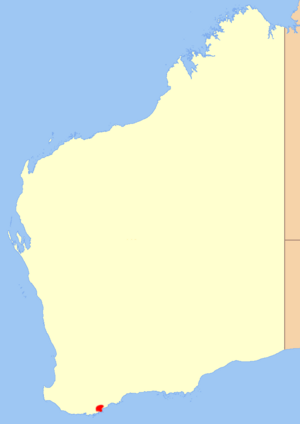Gilbert's potoroo facts for kids
Quick facts for kids Gilbert's potoroo |
|
|---|---|
 |
|
| Conservation status | |
| Scientific classification | |
| Kingdom: | |
| Class: | |
| Infraclass: | |
| Order: | |
| Family: | |
| Genus: |
Potorous
|
| Binomial name | |
| Potorous gilbertii |
|
The Gilbert's potoroo (Potorous gilbertii) is a small Australian marsupial. It is sometimes called a rat-kangaroo. This animal has a pointed face and is about the size of a rabbit.
Gilbert's potoroo was once thought to be extinct, meaning completely gone from the world. Now, it is listed as critically endangered. This means it is in extreme danger of disappearing forever. It is Australia's most endangered mammal and marsupial. There are only about 40 of these animals left in the world. This makes Gilbert's potoroo one of the rarest mammals on Earth.
They live in a small area of about 1,000 ha (2,471 acres). This area is on the southwest coast near Albany, Western Australia. It is part of the Two Peoples Bay Nature Reserve. Some Gilbert's potoroos have also been moved to nearby Bald Island. They are now breeding successfully there.
Contents
Discovery of the Gilbert's Potoroo
Scientists first officially discovered the Gilbert's potoroo in 1840. It was named in 1841 after John Gilbert. He was an English naturalist and explorer. John Gilbert collected several animals at King George Sound in Australia. One of these was this potoroo.
After its discovery, the Gilbert's potoroo was not seen for many years. People searched for them in the 1970s but could not find any. The species was believed to be extinct for 120 years. Then, in 1994, it was rediscovered in Two Peoples Bay Nature Reserve. A scientist named Liz Sinclair was studying wallabies. She caught the potoroo in one of her traps.
Where Gilbert's Potoroos Live
Potoroos live under thick bushes and shrubs. They make tunnels and paths through the bush. This helps them move around easily. When they move slowly, they use all four legs. But to move quickly, they can hop like a kangaroo.
Potoroos are nocturnal, which means they are active at night. They spend their days hiding. They do not often come out into the open. They usually live in small groups of three to five animals.
They eat different kinds of truffles and fungi. Australia has many types of truffles, and potoroos enjoy eating many of them. Potoroos have sharp, three-toed claws. These claws help them dig into the ground to find truffles growing in the soil. After eating them, potoroos help spread the seeds of the truffles through their waste. Scientists have found 40 different types of fungi in the waste from a Gilbert's potoroo.
Reproduction and Life Cycle
Female potoroos can have two babies in a year. However, they only carry one baby at a time. They can keep a second embryo in a state called diapause. This means the second embryo stops growing while the first one develops. If the first baby does not survive, the second baby can start growing right away.
We do not know exactly how long gestation (the time a baby grows inside its mother) is for Gilbert's potoroo. But it is thought to be about 38 days, similar to the long-nosed potoroo. The baby potoroo is only about 1 cm (0 in) long when it is born. It lives in its mother's pouch for about 4 months.
Saving the Potoroo
When Gilbert's potoroo was rediscovered, some animals were captured. This was to start a breeding program. The goal was to help increase the number of potoroos. A few young were born in the first couple of years. But then, breeding in captivity stopped. Many studies have looked at what they eat and how they live. Still, scientists have not been able to get the potoroos to breed well in captivity.
In 2001, a group called the Gilbert's Potoroo Action Group (GPAG) was formed. This group helps teach people about the potoroo. It also helps raise money for more studies and captive breeding programs.
In August 2005, three potoroos (one male and two females) were moved to Bald Island. This island is safe from animals like cats and foxes that might eat the potoroos. Since then, four more potoroos have been sent to Bald Island. They are helping to start a new breeding colony there.
There are many dangers for the survival of Gilbert's potoroo. Because they live in a small area, they could be lost in a bushfire. Foxes and cats could easily kill all the potoroos. There might not be enough potoroos to give them enough genetic differences to survive a virus. Also, there is not enough natural bushland at Two Peoples Bay. Too much land next to the nature reserve has been cleared.
Images for kids
-
Illustration by Richter in Gould's Mammals of Australia (1863)
-
Dorsal skin (Natural History Museum, London, 1841)
See also
 In Spanish: Potoro de Gilbert para niños
In Spanish: Potoro de Gilbert para niños







